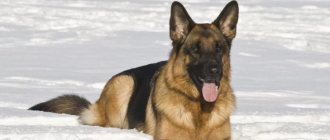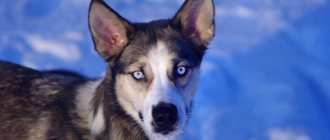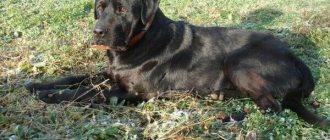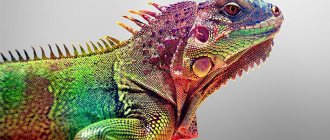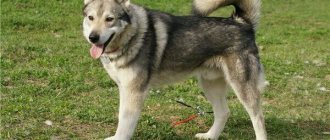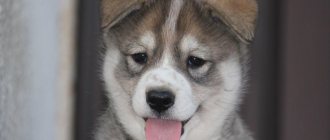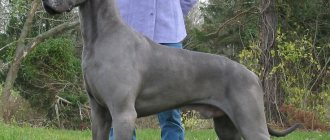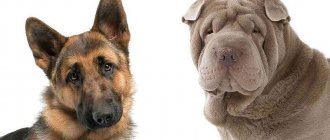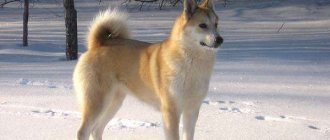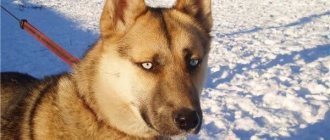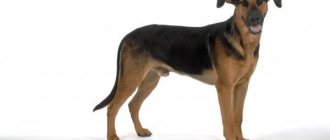For many novice dog breeders, the concepts of “hybrid” and “mixed breed” are equivalent. However, this is not entirely true, although both are “products” of crossing. Without delving into the dark forests of genetics, and skipping different stages of selection showdowns, in cynology it is customary to distinguish.
Hybrid puppy
- a puppy obtained by interspecific crossing of animals, that is, those that belong to different species and carry different sets of parental species genomes.
For example, wolf (Canis lupus) + dog (Canis familiaris) = wolfdog or wolfdog. These are different species united by a single family of Canids (Canis).
Metis or mixed puppy
- a puppy obtained by intraspecific crossing, and carrying 2 genomes that coincide with each other, regardless of breed.
For example, shepherd (breed) + husky (breed) = mixed-shepherd or laikoid, if the mother was a husky. They are the same species (Canis domesticis), but different breeds of dogs.
Mestizos cannot belong to any breed - they are purebred crosses and their genome appears to be various mosaic combinations of parental breed characteristics in a non-harmonious type of inheritance.
German Shepherd and Laika
The same applies to all other crossbred dogs, be it a cross between a shepherd and a husky, or a bullmastiff and a collie. The words “mixed” or “mixed” themselves come from the words “stir”, “stir”. This means that the babies from this crossing will have a mysterious mixture of the genes of their mother and father, which will certainly affect both the appearance of the growing dogs and their character.
Wolf dog character
The temperament of Czechoslovakian wolfdogs is also unique, as it distinguishes them from dogs and wolves.
It is not recommended to have such a pet for beginners who do not have experience with large service breed dogs. However, you should not think that the wolf dog has a wild and unbridled disposition, he just needs a strong hand, and the owner must become an authority for him, which is what the leader of the pack does in nature. With the right approach, the owner will be delighted with the qualities that the Wolfhund has:
- The dog is very loyal. The pack is the main priority for these hybrid dogs, for which he is capable of sacrificing his life without hesitation.
- Courage is another characteristic quality. The dog is of little interest in the size and number of offenders in his family. He will rush to defense frantically and show all his wolf ferocity.
- Independence. The Czech wolfdog has a developed intelligence, he is able to think and even in extreme conditions remains cold-blooded. This allows him to independently decide how to act. For example, if a child is drowning, the dog will not wait for the owner to give him a command.
- Endurance. There is a number of recorded data that dogs of this breed covered 100 km without stopping for a break, and their average speed was about 12 km/h.
- Volchak is a born guard. He can protect the house, its inhabitants and even things. If you invite your pet to guard the slippers, then until the owner hangs up, no one will approach them.
- Czech Wolfhunds are distrustful of strangers. Thanks to this quality, the dog remains incorruptible in any conditions; no treat or kind attitude will help win over the dog. Until the owner confirms that the people who came are his own, the wolf dog will watch them warily and wait for a “trick.”
- The dog is friendly. The Czechoslovakian Wolfdog can be kept with other pets, including dogs. Cats can be wonderful friends for the wolfdog. The only thing is that if you get large males, at certain moments they can show dominant qualities.
- This pet is very insightful. It is enough for a dog to see the owner’s gestures and facial expressions to determine what mood he is in, whether he is ready to communicate with his four-legged friend or whether this is not the best moment.
- Another quality of the wolfdog is sociability. Representatives of such a hybrid breed are not alien to the usual joys of a dog. They enjoy affection and attention from their family members. However, the dog will not impose his company if everyone is busy.
Features of the husky and shepherd mix
Considering the variety of breeds of shepherd dogs and huskies, there can be many options for their mixed breeds. There are also unofficial names for such dog “mixes”: laikoids (if the mother of the puppies is a husky) and shepheroids (if the mother is a shepherd).
It is impossible to predict whose character (shepherd or husky) will prevail in a puppy obtained from a mixed mating
In order to obtain hardy and obedient working dogs - universal service dogs - two popular breeds are most often crossed: the German Shepherd and the Russian-European Laika. Consolidating the desired qualities, in the second generation they infuse the blood of the breed whose image they want to strengthen - usually this is a shepherd dog.
Appearance
The exterior of a mestizo cannot be accurately predicted. But the union of a Russian-European husky and a German shepherd will predictably produce offspring that are large and constitutionally strong. The puppies will borrow the color from one of the parents: they will be either black and white, like the Russian-European husky, or black-backed, like most modern “Germans”. Wedge-shaped muzzle, erect triangular ears, two-layer thick coat - both breeds are similar in this
But how the tail turns out - “donut” or “saber” - is no longer so important
It is impossible to predict exactly what a shepherd-husky mix will look like.
Character and temperament
Crossing a shepherd dog and a husky produces deliberately active puppies, in which the advantages and disadvantages of the parents are unpredictably mixed. This dog can be recommended to an owner with an active lifestyle - it certainly won’t be phlegmatic. But you need to be prepared for quite probable disadvantages:
- tendency to frequent, loud and causeless barking;
- waywardness, frequent escapes;
- stubbornness, disobedience, unwillingness to follow commands.
Mestizos are smart, friendly to people and hardy, but they are not always suitable for protective service, since by nature they are often devoid of aggression towards people
A lot depends on the efforts of the owner - any dog is flexible in experienced hands. How successful they were will become clear by about eight months of age - then the puppy will enter the difficult adolescence period and show itself, as they say, in all its glory.
If contact between the owner and the mestizo is established, then you will get a wonderful friend
Attitude towards children
You need to be prepared for the fact that the mestizo will be less patient with children's pranks and familiarity. In such cases, the proud nature of the husky can rise up and suppress the tolerant shepherd dog. Simply put, to avoid problems, you should not leave such a dog alone with small children.
How does he get along with other animals?
The hunting inclinations of the husky make its mestizo not very loyal to small domestic animals. Such a dog is guaranteed to get along only with those pets with whom it grew up. What will happen to the rest is a big question. Most likely, a layoid will not deny itself the pleasure of hunting a cat, hamster or parrot - especially when the owner does not see it.
Trainability
Regardless of which parent’s blood will predominate in the mestizo, he will need systematic training - regular active exercises. Efforts should be directed towards those working qualities that it is desirable to develop in your dog.
The puppy's learning abilities should be excellent, although you will have to be more persistent and patient with him than with a purebred shepherd. You can begin a general training course from the age of five months, and protective guard service - no earlier than ten months.
Contact with the owner and systematic education of the mestizo will help avoid unpleasant and unexpected situations
Who are mestizos and how do they differ from purebred dogs?
Mestizos are the “fruits” of intraspecific crossing, in which both purebred and outbred animals can participate. Any mestizo is essentially a mongrel, and is by no means a new breed, as experimenters would like to think .
Shepherd and Laika - similar in appearance, but very different in character
From the first experimental mating to recognition of the breed is a long-term, thorny and costly path that only a dedicated and patient dog handler with a base of theoretical knowledge and extensive practical experience can do. Creating a new breed involves several mandatory steps:
- obtaining stable offspring from generation to generation;
- consolidation of general desired characteristics in appearance and behavior;
- formation of a fairly extensive gene pool of healthy dogs with well-predictable prospects.
Do not confuse mixed-breed dogs with hybrids: in the first case, crossing occurs within one species, Canis lupus familiaris, in the second, between different species of the canine family, for example, a jackal and a dog, a dog and a wolf, and so on.
To consciously obtain mixed breeds of various breeds, you must at least be guided by Mendel’s three laws:
- law of uniformity of the first generation - offspring in the first generation inherits the characteristics of only one of the parents according to the principle of dominance;
- the law of segregation - in the offspring of the second generation, individuals appear with the phenotypes of the original parental forms and the offspring of the first generation;
- the law of independent combination (inheritance) of traits - among the descendants of the second generation, individuals with new (relative to the parent) combinations of traits appear in a certain ratio.
The potential of a mestizo can be very interesting; it is the owner’s task to reveal it
Shepherds and huskies
You need to understand that huskies (like shepherd dogs) are not one breed, but a rather large and diverse group of breeds, each of which has its own characteristics, and often its own working specialization. This must be realized before forming a specific parent pair out of them.
Features of Laikas
The concept of “husky” unites about a dozen officially recognized and about the same number of unrecognized breeds. They are medium to slightly larger than average Spitz-shaped dogs that live in cold climates and have aboriginal roots. The FCI classification places all of them in the fifth group - “Spitz and primitive type breeds”.
Most huskies are universal working dogs that can combine two or more “professions,” but most breeds are still focused on certain work functions:
- hunting;
- sledding;
- security - rarely;
- shepherds - even less often.
Often, other northern dogs that are similar to them in appearance, for example, huskies, malamutes, and samoyeds, are indiscriminately classified as huskies, but this is a mistake.
For crossing with huskies, breeds that are distinguished by pronounced service talents, good trainability, obedience, and also “wolf-like” appearance are usually used. The results of such cross-linking can be really interesting.
Photo gallery: some breeds of huskies
The Russian-European Laika has a kind, easy-going character, but only for its owners; it is wary of strangers
The West Siberian Laika is obedient with its owner, but may not immediately follow commands. The Karelian-Finnish Laika is a kind, obedient, but quite proud dog, so you should not leave him alone with small children. The Karelian Bear Dog was originally intended to work as a wanted hunting dog due to its remarkable sense of smell.
The Nenets reindeer husky is an independent, intelligent, hardworking dog that can be used for protective guard duty. The East Siberian husky is not suitable for guarding, because it treats strangers more indifferently than aggressively. The Yakut husky is an indispensable assistant for humans in northern latitudes thanks to its excellent sense of smell. and the ability to navigate the terrain even in bad weather. Norwegian Huskies are suitable for various purposes, they are very smart, calm, and get along well with children.
Distinctive qualities of shepherd dogs
In the FCI catalog, shepherd dogs are classified in the first group - “Shepherd and Cattle Dogs”. They are even more numerous and diverse than huskies: about forty breeds have received official recognition. At least twice as many as yet unrecognized shepherd dog breeds have emerged in various territories around the world. All of them have a herding background, and many remain professional shepherds today.
Modern shepherd dogs have received new canine specialties - they serve in the police and customs, protect people and property, become rescuers, guides, and companions. The natural potential of these dogs is very great, and their ability to learn is extremely high.
Photo gallery: some shepherd breeds
The Belgian Shepherd (Malinois) is one of the most popular service breeds today - it is smart, obedient, quick in decisions and actions. The German Shepherd, unlike many other dogs, is able to easily change owners, which makes the breed especially valuable as a service dog
The South Russian Shepherd is a very independent, courageous and even aggressive dog. The Scottish Shepherd (collie) is a very smart and trainable dog, has innate abilities for shepherding. The Australian Shepherd (Aussie) has an open and friendly character, making it an ideal companion for humans. The French Shepherd (Beauceron) is an unusually vigilant and decisive dog, it prevents danger without waiting for a critical moment or a command from the owner. Caucasian Shepherd Dogs are excellent guards, they know how to be fierce and formidable when the property entrusted to them is in danger. The East European Shepherd Dog is easy to train and when With proper upbringing, he can become his owner’s best friend and a full member of the family.
The Komondor (Hungarian Shepherd) has a more developed herding instinct rather than a guarding one.
For what purposes are huskies and shepherds crossed?
Mixed-breed puppies can be born in different ways:
- accidental - dogs of different breeds are mated due to the owner’s oversight;
- irresponsibly experimental - according to the principle “I wonder what will come of it”;
- consciously - to obtain a working dog with improved qualities.
Often, ordinary large mongrels are sold under the guise of a husky-shepherd mix.
The first two options can be ignored: a normal breeder will not breed notorious mongrels without caring about their future fate. As for the third: within the framework of official cynology, where interbreed matings are prohibited, such experiments remain, as it were, illegal. But it is quite possible to understand the breeder’s natural desire to improve the degrading dog population:
- stabilize the nervous system;
- strengthen the immune system;
- increase endurance;
- improve the musculoskeletal system;
- consolidate working qualities and expand their range.
The purpose of crossing is to obtain a new large, hardy, active, intelligent and easy to train dog
Mixed Chihuahua and Mini Pinscher
Another amazing cross is the chipin. Like its parents, the puppy will be miniature, “pocket” size. Therefore, it is very small and fragile and requires only careful handling.
From the miniature pinscher, the mixed breed gets high intelligence: chipins learn very quickly and learn new commands. Unlike independent and willful Chihuahuas, they feel great in families with small children.
Chipins do not require special care: all you need to do is brush their short, stiff coat from time to time. Do not forget about the timely socialization of the mestizo so that he grows up as a friendly and good-natured creature.
Photo of a cross between a mini pinscher and a chihuahua:
Photo gallery
Summarizing the above, we can conclude that when deciding whether to get a hybrid Laika, you need to weigh the pros and cons, taking into account all their positive and negative differences from their purebred counterparts.
Character and behavior
Shepski is not characterized by such a character trait as aggression towards people. The animal has a well-developed territorial instinct, so it is used as a guard. They bark angrily at uninvited guests on their territory. Such a dog will not become a bodyguard or a member of the protective guard service. Among other things, a mestizo can behave aggressively with animals that it perceives as prey, for example, with cats or birds.
Since the Shepherd Husky mix is characterized by food aggression and extreme possessiveness in character, it is worth it from an early age. The animal must understand who is the boss in the house, how to behave with children and other pets. The child should also know that such a dog should not be disturbed while eating or anything taken away from him.
This is an intelligent, energetic, affectionate animal. Despite the fact that the dog loves his owner, he is significantly inferior in devotion to the German Shepherd. Raising a mestizo should begin at the age of three months. For consultations on training, it is worth contacting specialists.
However, the owner should remember that it is quite difficult to predict the puppy’s temperament, since each animal is individual. The pet will inherit some characteristics from its mother, others from its father. That is why before crossing, all the characteristics of both parents are carefully studied.
Which dog to choose, who is stronger, smarter, better?
Before getting a dog, you should compare it with other breeds - this will help form a more accurate idea of the character and abilities of the future pet.
Labrador
Labradors are loving, affectionate and friendly dogs towards absolutely everyone.
They are quite intelligent and amenable to training, but are inferior in this regard to shepherd dogs, for whom service is their main calling.
Shepherd dogs are also superior in jaw grip strength, but Labradors are still more agile and nimble pets.
Pitbull
Despite their more compact size, pit bulls are superior to shepherds in strength - they are more powerful, have a stronger jaw grip and are better suited to participate in fights.
"Caucasian"
“Caucasians” are excellent watchmen and bodyguards; even the “Germans” cannot compare with them in this regard. They are also ahead of their relatives in terms of aggressive behavior towards children, other animals and strangers. Caucasian shepherd dogs are much larger than German ones and surpass them in strength and power.
Wolf
Wolves are hardy, capable of reaching speeds of up to 60 km/h, and the clenching force of their jaws is 2.5 times higher than that of fighting dogs.
There are very few dogs capable of fighting a wolf, and those who can win are even fewer, and German shepherds are not one of them.
Types of crossbreeds
With a German Shepherd
Labrador and German Shepherd mixes, inheriting the best traits of their parents, are distinguished by a friendly and playful disposition, but at the same time they make very good guards.
The Labronemese sensitively guards a house or apartment, but is not characterized by increased aggressiveness or excessive vigilance.
Outwardly, such a dog may look like one of its parents, but its appearance will certainly contain exterior features of another breed. Typically, they have floppy ears, medium-length fur, and a saber-shaped tail.
With an East European Shepherd
They are similar to the previous type of mestizos, except that crosses of Labradors and “Easterns” are distinguished by their taller height and powerful physique.
Such mestizos are loyal, quite obedient and at the same time sociable. At the same time, they take their work seriously and are calmer.
With a Caucasian Shepherd
Such mixed breeds of Labrador and Caucasian, as a rule, look very large and powerful.
Their fur is quite long and thick, protecting them well from the cold.
These dogs have drooping ears, but can also be cropped. The color varies, and there may be white markings or a dark mask on the face.
It should be remembered that a crossbreed between a Labrador and a Caucasian Shepherd may have a difficult character: such a dog sometimes grows up willful, stubborn, overly distrustful of strangers and even malicious.
In order to avoid problems associated with negative character traits, a Labrador and Caucasian Shepherd dog mix needs early socialization and proper education and training.
At the same time, if you pay attention to such a pet and train it correctly, it can grow into an intelligent, moderately vigilant and brave dog.
What it looks like in the photo and dimensions
- The size of such mestizos will be approximately 50-65 cm, and their weight will be about 18-23 kg.
- The bones are square or slightly elongated, quite strong and with well-developed muscles.
- The head is wedge-shaped or in the shape of an isosceles triangle, with a moderately wide skull and a slightly smoothed transition to a pointed, but not too narrow muzzle.
- The ears are erect, triangular, and usually of medium size.
- The eyes are almond-shaped or oval, their color can be brown or blue, or different.
- The nose is usually black, but mestizos also have “snow” pigmentation, in which there are light veins on the nose.
- The neck is muscular and strong, the withers are well defined, the back is straight, the croup is slightly sloping. The chest is developed, moderately wide and deep, but not massive. The belly is tucked in, with a defined curve.
- The forelegs are straight and parallel, the hindquarters are strong and moderately muscled. The tail is of medium length, well feathered. Usually carried on the back in the form of a complete or incomplete ring, it can also hang to the side or be sickle-shaped.
The coat of Hasko Laikas is very thick and dense, with a well-developed undercoat and rough hair.
Expert opinion
Kozhevin Semyon Kirillovich
Expert dog handler.
“A crossbreed between a husky and a husky, if it inherits the best qualities of both breeds, will be suitable not only as a sled dog or an ordinary pet. Considering that all real huskies are excellent hunters, he will have well-developed hunting instincts, and, unlike a husky, who hunts game only for himself, these dogs will track the animal specifically for the owner. Mixed huskies and huskies will do a good job of guarding a house or apartment, since they treat strangers, albeit without strong aggression, but with distrust. At home, such a pet will be friendly, obedient and gets along well with children. Husky Laikas also have one more positive quality: they rarely get sick and, as a rule, are not susceptible to hereditary diseases.”
Features of the husky and shepherd mix
Considering the variety of breeds of shepherd dogs and huskies, there can be many options for their mixed breeds. There are also unofficial names for such dog “mixes”: laikoids (if the mother of the puppies is a husky) and shepheroids (if the mother is a shepherd).
It is impossible to predict whose character (shepherd or husky) will prevail in a puppy obtained from a mixed mating
In order to obtain hardy and obedient working dogs - universal service dogs - two popular breeds are most often crossed: the German Shepherd and the Russian-European Laika. Consolidating the desired qualities, in the second generation they infuse the blood of the breed whose image they want to strengthen - usually this is a shepherd dog.
Appearance
The exterior of a mestizo cannot be accurately predicted. But the union of a Russian-European husky and a German shepherd will predictably produce offspring that are large and constitutionally strong. The puppies will borrow the color from one of the parents: they will be either black and white, like the Russian-European husky, or black-backed, like most modern “Germans”. Wedge-shaped muzzle, erect triangular ears, two-layer thick coat - both breeds are similar in this
But how the tail turns out - “donut” or “saber” - is no longer so important
We recommend reading: Instructions for use of Ovariovit
It is impossible to predict exactly what a shepherd-husky mix will look like.
Character and temperament
Crossing a shepherd dog and a husky produces deliberately active puppies, in which the advantages and disadvantages of the parents are unpredictably mixed. This dog can be recommended to an owner with an active lifestyle - it certainly won’t be phlegmatic. But you need to be prepared for quite probable disadvantages:
- tendency to frequent, loud and causeless barking;
- waywardness, frequent escapes;
- stubbornness, disobedience, unwillingness to follow commands.
Mestizos are smart, friendly to people and hardy, but they are not always suitable for protective service, since by nature they are often devoid of aggression towards people
A lot depends on the efforts of the owner - any dog is flexible in experienced hands. How successful they were will become clear by about eight months of age - then the puppy will enter the difficult adolescence period and show itself, as they say, in all its glory.
If contact between the owner and the mestizo is established, then you will get a wonderful friend
Attitude towards children
You need to be prepared for the fact that the mestizo will be less patient with children's pranks and familiarity. In such cases, the proud nature of the husky can rise up and suppress the tolerant shepherd dog. Simply put, to avoid problems, you should not leave such a dog alone with small children.
How does he get along with other animals?
The hunting inclinations of the husky make its mestizo not very loyal to small domestic animals. Such a dog is guaranteed to get along only with those pets with whom it grew up. What will happen to the rest is a big question. Most likely, a layoid will not deny itself the pleasure of hunting a cat, hamster or parrot - especially when the owner does not see it.
Trainability
Regardless of which parent’s blood will predominate in the mestizo, he will need systematic training - regular active exercises. Efforts should be directed towards those working qualities that it is desirable to develop in your dog.
The puppy's learning abilities should be excellent, although you will have to be more persistent and patient with him than with a purebred shepherd. You can begin a general training course from the age of five months, and protective guard service - no earlier than ten months.
Contact with the owner and systematic education of the mestizo will help avoid unpleasant and unexpected situations
Care and maintenance
With yard keeping, caring for a cute mestizo will not be a problem even for a beginner. The main thing is that the owner has enough time and desire to take care of his pet.
Hygiene
Simple hygiene procedures usual for dogs are necessary in this case, including:
- cleaning eyes - daily;
- gentle ear cleaning - weekly;
- checking the condition and, if necessary, cleaning your teeth - monthly;
- combing - 2-3 times a week, and during periods of shedding - daily;
- swimming - no more than once a quarter.
The main problem of both original breeds is strong seasonal shedding, which makes it difficult to keep mixed breeds in an apartment. And by nature, it is more natural for such a temperamental dog to be in a spacious area than in cramped rooms.
Feeding
The diet of mixed breeds, its calorie content and the volume of portions should be calculated taking into account the load on the dog. The more physical activity a pet exhibits, the more energy it must replenish through feeding.
Nutrition also depends on the time of year - during cold periods the dog requires increased feeding.
Many owners of huskies are adherents of natural nutrition, but for mixed breeds with shepherd dogs, it is still worth recommending ready-made food: they are balanced and make it easier to regulate the required amount of calories, as well as the ratio of proteins, fats, carbohydrates and mineral and vitamin supplements. You can pay attention to such proven and high-quality products:
- Brit Care Endurance;
- Belcando Adult Active;
- Baskerville Active Dog;
- GO! Natural Daily Defense Lamb Dog Recipe;
- Acana Sport & Agility.
A German Shepherd-Lusika mix can eat ready-made food for active adult dogs - this is preferable to homemade natural food
Husky mixes have a high metabolism, so they need to drink more than regular dogs. Make sure your pet always has enough clean water.
Video: the wonders of raising a crossbreed Laika and German Shepherd
Walk
A crossbreed between a husky and a shepherd dog will retain puppy activity and curiosity even at a very advanced age. A long walk will always remain important for him - a total of at least three to four hours a day. This rule is also mandatory for those dogs that have the opportunity to move freely throughout the spacious territory of a closed private yard.
Mixed dogs of huskies and shepherds need long and active walking
Vaccinations
The complex vaccination scheme is common for all dogs - both purebred and outbred: mandatory vaccinations are given to the puppy at 8 and 12 weeks of age after antiparasitic treatment. If you live in an area with an increased risk of infection, you can carry out a third vaccination - at six months of age, after a complete change of teeth. The first rabies vaccination is given to a puppy at three months. Then comprehensive vaccination is carried out annually throughout the dog’s life.
You should discuss the choice of a complex vaccine with your veterinarian - which one is most effective specifically in your region of residence.
A little history
A cross between a Rottweiler and a German Shepherd appeared in the mid-20th century. The breed is considered young and still little known throughout the world. Germany became her homeland. A group of Germans set out to get new dogs with a stable psyche and balanced character.
Particular attention was paid to the level of health
The best representatives of the breeds were selected for the work. The first mixed breeds of Rottweilers and German Shepherds definitely pleased the breeders. Hybrids were distinguished by high trainability, obedience, and good health.
Further crossing allowed only the best qualities to be consolidated in the new breed. Therefore, the breeders decided to present the Rottweiler-Shepherd mix to the professional canine society.
Rottweiler and Shepherd
However, experts refused to recognize the new breed. In their opinion, mestizos do not have a stable set of characteristics, and the results of selection are not yet permanent. At this stage, the targeted work on breeding a new breed ended.
Interesting! Some dog breeders make their own hybrids and sell puppies.
The Rottweiler-Shepherd mix is considered to be versatile and has excellent working qualities. This breed is popularly called Malkhover, and it is popular among connoisseurs of unusual dogs.
Breeding versus plain mating
It is fundamentally wrong to consider selection work to create a new breed and random or “for the sake of curiosity” mating as the same thing. To develop a new breed, breeders do a tremendous amount of work. Their goal is to consolidate the necessary mental qualities and physical characteristics in the breed through long and tough selection.
It was precisely these goals that the breeders from the former GDR pursued when crossing the Rottweiler and the German Shepherd. They wanted to breed a harmoniously built, hardy and mentally balanced dog, which is exactly what they achieved. The breed was called Malchover, but it never received official recognition.
However, fans of the Rottweiler-German Shepherd hybrid still exist. After all, such versatile dogs do an excellent job with protective, guard, search and security services. But, despite the loyalty, activity and obedience taken from the shepherd, mestizos have the stubbornness, aggression and dominance of Rottweilers. Therefore, to keep the dog under control, the owner must have leadership qualities.
Popular types of mestizos
Already in ancient times, interbreeding was widely practiced by breeders interested in obtaining a high-quality and healthy stock of their dogs. Most modern breeds, in fact, are descendants of those same mestizos.
And later, when it was necessary to improve the working qualities of dogs of a breed that had already managed to form, specialists also resorted to interbreeding.
Malamutes have been bred in Eskimo tribes for a long time and the purity of their blood has been respected since ancient times. Strong, hardy dogs, designed to transport sleds with heavy loads, were necessary for local residents and they were not interested in in any way changing the exterior or working qualities of Malamutes by crossing them with other dogs.
However, after the breed was officially recognized and these dogs began to be used in sports, there was a need to improve the speed qualities of Malamutes, for which they were actively crossed with dogs of other sled breeds, but with a faster gait.
As a result, such a breed group as, for example, Alaskans - mestizos of Malamutes and Huskies - was born. These dogs, having the same endurance and almost not inferior to purebred Malamutes in strength and endurance, are at the same time distinguished by an incomparably faster gait, which makes them universal sled dogs, suitable for both moving heavy loads and racing at speed.
NOTE!
The popularization of Malamutes and their use as companion dogs has led to the need to improve their watchdog and security qualities.
To achieve this, Malamutes were crossed with service breed dogs, such as the German Shepherd.
In addition, attempts have been made to improve the hunting qualities of Malamutes, since, despite their innate instincts, these dogs hunt only for themselves and only when they themselves want it. In order for the Malamute to become a faithful hunting assistant, attempts were made to cross it with various breeds of husky.
Lately, so-called designer dog breeds have been gaining popularity, in which the purpose of interbreeding is, first of all, the unusual appearance of mestizos.
Of course, the beautiful appearance of a purebred Malamute cannot leave anyone indifferent. However, some breeders began to think about how to make these dogs even more unique and original in terms of appearance.
For this purpose, Malamutes were crossed with breeds such as Chow Chows, and, indeed, such mestizos became the owners of a very interesting and unusual appearance.
Nutrition for mixed pets
Mixed-breed dogs require a rational, balanced diet, taking into account the nutritional value and calorie content of foods. It is especially important to feed puppies adequately, since the correct development of the skeletal and nervous systems is laid down in childhood. A lack of essential microelements can lead to rickets in your pet.
Note! The daily nutritional intake, taking into account the necessary vitamins, macro- and microelements, is difficult for a non-professional to calculate. The veterinarian will help you create a complete menu for your pet.
The diet of mixed breeds is compiled taking into account the dog’s weight, its metabolism and the characteristics of the parent breeds. The husky-shepherd mix has a fast metabolism, moves a lot and has a good appetite. She is fed natural food, which contains:
- cereals;
- dairy products;
- meat;
- cereals;
- vegetables;
- meat by-products;
- vitamin supplements and minerals.
A puppy needs dairy products for normal development.
It is also possible to include high-quality dry food in the diet, which contains a balanced daily intake of nutrients. Mixed-breed puppies are fed three to four times a day; an adult animal needs two meals a day.
Character
One of the main differences between these breeds is their bark. Huskies do not make such sounds - they only howl. You can even say this: they sing like wolves. But huskies, on the contrary, bark, which is why they got their name. True, their barking is always different, depending on the situation. But when they hunt, they behave absolutely quietly, and will only bark when they find prey.
And you can also note one more difference - endurance. Huskies have excellent physical fitness. They can easily cover long distances at high speed without being distracted by food. Laikas, intentionally bred for transport purposes, are also hardy, but not as hardy as huskies. They usually transport not too heavy loads and only over short distances.
And with its help, all issues with the outside world are resolved, for example, relationships with other family members or pets. In addition, they clearly have such character traits as love of freedom, phlegmatism and independence.
Huskies, on the contrary, are very loving. They treat any person with all the warmth, even strangers. They are believed to become attached to people almost instantly and treat them very well. However, they do not have guard instincts, so, unfortunately, they are no defenders.
The interesting thing is that when these breeds are mixed, it turns out that the puppy inherits only the best qualities from its parents. They have great personalities, adapt well to living with people and serve them well. Husky-husky crossbreeds are quite easy to train and quickly remember everything. They always show loyalty and treat children with all tenderness.
Mestizos are more similar in appearance to huskies. Most crossbred offspring appear with a blue eye tint. But there is a different palette of shades. If you put in more effort, you can get a dog with heavenly eye color and black fur. In addition, it is possible to breed an animal of a bright red color. Having received a red offspring, a real dog breeder will be happy with this news, but it is better to keep it not in a city apartment, but in a large house with a plot. But those individuals that are more tamed to people will become great friends, living in apartments.
But before you buy a mestizo, you need to accept the fact that not all babies receive only positive qualities. Of course, there may be different options. Therefore, it is worth observing how the puppy behaves, and only then make a decision.
The main differences between the German Shepherd and the Eastern European
Despite the fact that dogs belong to the same breed group and have a similar appearance, there are a number of differences between them. First of all, this applies to animal physiology.
Exterior and paint
The anatomical differences between breeds are noticeable even to a non-specialist.
These are parameters such as:
- Back line. The German croup is distinctly sloping, smoothly merging into the base of the tail. The Eastern European is distinguished by a flat back line (the difference in height at the withers and height at the rump is 2 cm).
- Hind legs. The hind legs of the Veo in a natural stance are slightly pulled back; in the German they are far apart and squat.
- Fur cover. Among Germans it varies from medium size to long, while among Easterners only medium length is allowed.
- Size. Veo is larger and heavier than HO.
- Wool coloring. The main color of the Germans is black and red (from red to light yellow), in addition, zonal colors are allowed - gray with a mask and black. Among Easterners, black saddleback against a background of clearly contrasting main color and pure black are allowed. The palette ranges from light gray to fawn.
German ShepherdEast European Shepherd
Character and ability to train
Please note: the basic personality traits of these two breeds are identical. Shepherds are well-managed dogs, with a balanced psyche, distrustful of strangers
The ability to learn is extremely high. With a properly constructed motivation system, even a novice dog breeder can cope with raising a puppy.
They can be involved in any of the services, engaged in sports training, trained as rescuers and guides, or used as pets.
Temperament
Despite the general similarity of character, Veos and Germans differ significantly in temperament. Most Germans are choleric: they are easily excitable and love to express emotions with loud barking. Eastern people are sanguine - they are slower and more balanced.
It is worth noting that Germans brilliantly participate in almost all types of sports training, largely due to their bright temperament.
The East European Shepherd is calm and self-possessed. The German is very mobile and hardy, can keep a scent for a long time and run long distances.
Veo's potential in this regard is somewhat weaker. Due to less excitement and larger dimensions than other shepherd dogs, they are inferior in entertainment and speed to the same Germans, not to mention the Malinois, which is rapidly gaining popularity.
Position of rocks
The East European Shepherd breed is listed only on the territory of the Russian Federation and former Soviet republics.
She did not receive recognition outside our country. FCI considers it a side line of the German ones, bred in the USSR.
Why are mestizos needed?
It would seem a strange question, because in the usual understanding, a mestizo is the fruit of a random connection between two breeds of dogs. But it is not so.
Firstly, mixed breeds are often deliberately used by breeders to improve and develop various breeds. The process is complex and involves the use of compacted inbreeding, when the resulting foreign gene is gradually replaced by conservation of the desired genes.
Secondly, mixed breeds of shepherd dogs and huskies are often crossed in order to obtain second generation mixed breeds and raise them into dogs of the desired orientation, even if they are not purebred. Thus, in some former Soviet republics, it is common practice to obtain shepherds and laikoids from large German and East European shepherd dogs with local huskies.
The purpose of crossing is to obtain a new large, hardy, active, intelligent and easy to train dog
The resulting individuals are the “base” for obtaining the second generation of mestizos.
When the dogs are formed, they are again covered with “pure” dogs, splitting the doubled gene and thus strengthening the dogs’ inclinations. The result is large, well-developed, tireless in hunting, intelligent and fearless dogs, attached to their owners until their last breath and easily trained for any type of activity.
These dogs are highly valued because they combine the excellent working qualities of both breeds.
Breeding
Often puppies are the result of accidental love, but there are breeders who deliberately cross a shepherd and a husky. This is done for the purpose of improving and developing the two breeds. This is a difficult and long process of compact inbreeding. You have to wait a long time until the unnecessary gene is replaced by the genes of other individuals. Often the breeder’s task is to obtain second-generation mestizos in order to raise outbred individuals of a certain orientation. Some former Soviet republics are specifically engaged in breeding mixed-breed shepherd dogs and huskies.
The result of mixing two radically different breeds is a powerful, efficient and intelligent dog. From such individuals it is possible to raise full-fledged healthy puppies of the second generation. Mature dogs are crossed again with purebred individuals, splitting the doubled gene and increasing the desired characteristics of the dog. The fruit of love between a shepherd dog and a husky takes on the best qualities of both parents.
Description of the breed
German Shepherd and Husky mixes do not have official recognition in the FCI and RKF, but they are registered in the American Hybrid Dog Cube.
Moreover, they have several names there:
- German Husky
- Siberian Shepherd
- Shepherd Husky
- Gerberian Shepski
In Russia, such dogs are called Gerber Shepski or simply Shepski.
They were not bred out of whim, but in order to make German shepherds more adapted to the harsh climatic conditions of the northern states of the United States; it was also planned that such dogs would participate in Arctic and Antarctic expeditions.
The fact is that, although shepherd dogs have long been used in America for herding reindeer and for search and rescue work, they could not successfully cope with their duties in severe snowstorms and blizzards, which are frequent in those places.
To increase the frost resistance of the German Shepherd, the blood of a husky was infused into it, which is distinguished by its ability to work in the conditions of the Far North.
As a result, the breeders received a large dog with an interesting appearance, which inherited the features of both of its parents.
But the Shepski, as it turned out later, lost many of the best qualities of the original breeds and did not acquire the endurance for long-term work in the conditions of the North.
The interesting appearance of these dogs could not help but interest the first breeders, who, abandoning official use, began to breed them as companion dogs.
Shepski can only be called a mixed breed obtained from a male German Shepherd and a female Husky. Dogs born in the second generation after hybridization cannot be classified as such. In the same way, puppies whose father is a husky and whose mother is a shepherd cannot be considered Shepski.
When breeding these dogs, one more feature was revealed that made breeding the Shepsky as a separate breed impossible: mixed breeds of German shepherds and huskies turned out to be incapable of passing on the best exterior and working qualities to their descendants.
Such dogs are currently bred directly from shepherds and huskies. They are used either as companion dogs or for canis therapy.
Their service use is extremely difficult due to the fact that the Shepsky is not characterized by aggression and unquestioning obedience, which is necessary for service dogs.
From Greif to Horand: the formation of the German breed
The first written mention of the ancestors of German Shepherds dates back to the 7th century. During excavations in Swabia (southwestern region of Germany), a document was discovered describing large wolf-like dogs that lived in human settlements. The manuscript does not contain information about the then name of the dogs or their purpose, but it contains the most curious fact: killing a dog was considered a serious crime for which the killer was sentenced to death.
Despite its centuries-old history, the formation of the German Shepherd breed began only in the 19th century. Many people, both professional breeders and businessmen pursuing selfish goals, tried to create a new breed of dogs with ideal external data and a set of qualities such as intelligence, devotion and unquestioning obedience to the owner. But only one person was able to achieve success in this field and his name was Max Emil von Stefanitz.
Mr. Stefanitz was not a dog trainer or an experienced breeder. He held the position of captain in the cavalry forces, where his duties included the purchase and drill training of war horses. On duty, von Stephanitz traveled all over Germany, often visiting rural areas and farms, where he noticed shepherd dogs deftly managing livestock grazing. Max liked the animals so much that after retiring, he decided to devote his life to a noble goal - creating a breed of dogs that would become a national treasure of the country.
A long search for shepherd dogs that meet the given parameters, several years of painstaking selection work, and now the first name of a representative of the new breed - Greif - was entered into the stud book. The dog had a powerful physique, endurance and unconditionally obeyed any order. Only one thing upset von Stefanitz: the appearance of the pet, or rather its dull, dirty-gray color, was not quite suitable for the future symbol of Germany.
And the retired captain again began searching for the ideal dog, until at one of the exhibitions he saw a dog entertaining the audience with funny tricks. Von Stefanitz looked at the male dog named Hector with admiration and could not believe his luck. The dog had strength, agility and an ideal physique, but most importantly, Hector had an impeccable yellow-gray coat color. Max immediately offered the owner of the shepherd a decent amount for the dog, but he became stubborn and flatly refused to sell the pet. Mr. Stefanitz pursued the intractable owner for several months, and his persistence was crowned with success. Hector was bought out, renamed Horanda von Grafrath and transported to Max's kennel.
And the breeder's Horand did not disappoint! Max's favorite pet has repeatedly become a champion and prize-winner of various exhibitions. But the main thing is that Horand turned out to be an excellent sire, his offspring were distinguished by good health and inherited only the best qualities from their father. So the dog with an aristocratic name, beautiful exterior and positive character became the official ancestor of the new breed.
Inspired by this success, in 1889 Stefanitz, together with like-minded people, founded the first German Shepherd Club. Through their joint efforts, a description of the breed, exterior standards and the nuances of their breeding were included in the stud book. And it took only 20 years for these amazing animals to be recognized far beyond the borders of Germany.
Mixes with large and medium dogs
Among the hybrids where huskies were crossed with large dogs, the following should be highlighted.
Shepherd and Husky
A dog from such large parents will inherit its size; in addition, the pet will be a short-haired animal, which greatly simplifies its maintenance in the home. The puppies will inherit an active and playful disposition from their northern ancestor, so you will need to take the mixed breed for regular walks in the fresh air. As for the German Shepherd, it will transfer its strength and developed intelligence to the hybrid, which will be an undeniable advantage when training a pet.
In terms of appearance, it will be difficult to predict which features will be dominant, but in most cases the dogs will have blue eyes and a color reminiscent of the “German”.
Golden Retriever and Husky Mix
As a rule, the Siberian subspecies is crossed, and the cross-bred animals are called rehaskis. Animals will have a balanced disposition; pets are very obedient. The result of crossing in terms of exterior will be a dog with a predominant external resemblance to a retriever, so the color of the pet will be in light colors.
Akita inu with husky
In animals, in terms of exterior, the genes of the first breed of dogs will dominate. In terms of character, pets are characterized as purposeful, in some cases even stubborn, four-legged friends of humans, which will not always be beneficial. A mixed breed can inherit certain facial features from a husky. Also, from the northern ancestor, the hybrid will receive pronounced nanny instincts.
Labrador and husky
Externally, an adult pet will strongly resemble its wild ancestor - the wolf, except for the exterior; the similarity can also be seen in the character of the animals obtained by crossing these two breeds of dogs
It will be extremely important for your pet to occupy a leading position; any attempts to show disrespect can cause aggression on his part. Such a mestizo will require mandatory training, however, in terms of training and education, a strict owner must demonstrate goodwill
Dogs require active and long walks and games.
Shar Pei and Husky mix
Metis stands out for its unusual exterior with a predominance of Chinese genes. The hybrid is also notable for its quality that it will be almost impossible to predict the dog’s color in advance. Pets stand out for their high intellectual qualities and are friendly towards humans, younger family members and other pets. From the husky, the hybrid inherited the need for long walks and getting new experiences.
Husky and chow chow
In appearance, the mestizo resembles its Chinese parent, this also applies to the color of the coat and voluminous coat. The dog's muzzle resembles a forest animal. From a husky, animals will take light eye color, height that exceeds the established standards for a bear dog, as well as the outline of spots on the fur coat. The animals are quite friendly in nature and get along well with children. However, hybrids require professional training.
Mestizos Laikas
Such a mixed breed is considered the most successful option, since the animals will turn out to be natural hunters and watchmen. However, pets will be characterized by some selfishness in behavior, as well as hyperactivity. These dogs are recommended for families with small children. The only conditions for keeping a hybrid are to provide it with suitable living conditions. Animals kept in an enclosure will need to have a shaded area so that the dog has the opportunity to avoid overheating during the summer months.
Hybrid of Husky and Malamute
They are very strong and hardy animals, so pets are often used in various competitions. Such dogs are considered loyal and loyal companions and are easy to train. In addition to the above hybrids, there are huskies crossed with Rottweiler and Doberman. The mixed-breed Dalmantine is popular, northern dogs are found with breeds such as the Samoyed, there is a hybrid of a husky and a pit bull, a mixed breed with an Alabai, a bulldog, and Stafford, Shiba Inu, and beagle are used for crossing.
Advantages and disadvantages
The Shepherd is a popular, intelligent, brave, loyal and obedient dog breed. Purebred dogs bred in special kennels have the correct conformation, endurance, and learn quickly.
Compared to a purebred dog, a crossbreed has a number of advantages:
- the puppies are strong and healthy;
- resistance to genetic diseases;
- immunity is developed;
- intelligence is more clearly expressed;
- the cost is lower than a purebred.
The excellent health of a crossbreed does not mean that they do not need care, care and proper nutrition.
When keeping a crossbreed as a pet, you should remember the following disadvantages:
- the size and color of an adult dog cannot be determined;
- flaws in appearance;
- have no documents or pedigree;
- cannot participate in exhibitions;
- unknown character of the pet: it can be either affectionate or aggressive.
Scientists have proven that crossbred dogs are the best option, since the puppy takes only positive qualities from its parents. When mating two different dogs, the negative qualities of the breed are compensated.
